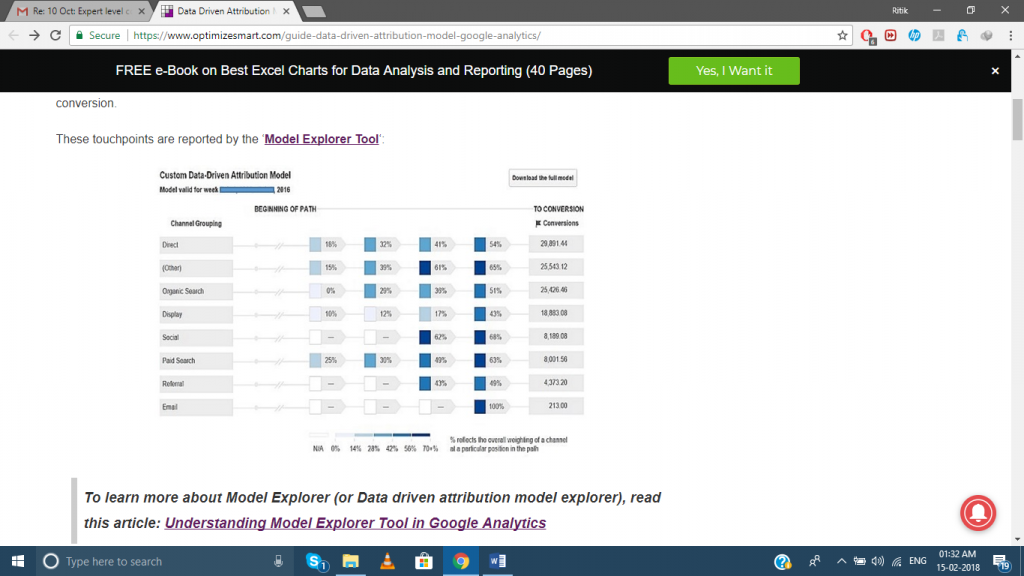
Google Analytics is used by more than 28.8 billion websites since its inception in 2005. And many have attempted to find a ‘one size fits all’ approach as far as attribution models are concerned.
While this is admirable in and of itself, it also goes against the very nature of Google Analytics. After all, the USP of the service is to customize reports according to your requirements. So why should attribution models be any different?
What is attribution?
Before we dive in any further, however, you must understand what we mean by attribution. In Google Analytics, the term attribution can mean lots of things, from giving credit for visiting the website to completing a particular activity, from a campaign to a kind of source. Attribution is mainly used for conversions and sessions.
Data-driven attribution
Now, attribution models can be of various kinds, but the one generating a lot of buzz lately is data-driven attribution. Rather than a traditional model, this algorithmically-generated model is exclusive to customers of Google Analytics 360 which offers an easy way to provide personalized experiences to your customers. Plus, you need to meet these two parameters across a period of 28 days:
- 400 conversions of every type with a minimum of two interactions in every conversion.
- 10,000 paths on your site, which is akin to 10,000 site users. However, a single user can create numerous navigational paths.
The standout feature of data-driven attribution is how it considers the touch points of the users before the start of the conversion process. The Model Explorer Tool reports these touch points. The data is then reviewed.

The data-driven attribution model serves as a baseline model in Google Analytics, enabling you to create new personalized attribution model. Create the new data-driven attribution model to share conversion credit with multiple touch points along the path of conversion before the implementation of personalized credit rules.
Use the data-driven attribution model to analyze both, the non-conversion and conversion path information. The latter is data gathered from visitors who were not converted by your site while the former is collected from the ones who did convert. A unique aspect of the data-driven attribution model is how it changes weekly.
Why does the data-driven attribution model work?
Understand that this model offers credit to the conversions of various touch points or marketing channels according to what they contributed in the conversion process. The touch point or marketing channel that offers the most assistance receives the most amount of credit for conversions, irrespective of whether it’s the initial touch, the middle touch, or the last touch. The rest of the touches or channels receive credit as per what they contributed during the conversion process.
As the task of assigning conversion credits depends on the latest conversion information rather than the touch point positions, the attribution becomes data-driven. This not only eliminates the need to assign random conversion credit to numerous touch points or channels but also explains why the entire model is called the data-driven attribution model.
Make it a point to remember that the validity of data-driven attribution lasts for a certain period of time since the model changes along with the conversion information.
What your business needs to implement the DDA (Data-Driven Attribution) model?
Never think for a second that an algorithm-based attribution model such as this one can be implemented by every business. First, meet and maintain various strict requirements, and only then can your business handle the data-driven attribution model.
-
Access to a Google Analytics 360 account
Unless you have a Google Premium or Google Analytics 360 account, you cannot use the data-driven attribution model.
-
High-quality data and its availability
Always remember that your DDA model’s strength rests on the information you submit. So a poor entry will beget poor results.
Now, the problem is, most organizations might be able to download and install Google Analytics 360, but they stumble hard when it comes to figuring out how to benefit from the service.
What’s more? Even though they have the resources to hire experienced analysts, they cannot always create and maintain large volumes of quality data gathered from different data sources.
Thus, the insights received from the DDA model are likely misleading, flawed, and unusable.
-
Compatibility of KPIs and goals
The KPIs and goals you select for your business need to align across organizations and marketing channels. Otherwise, the data-driven attribution model does not work. So, if the primary Twitter campaign target is to improve site sales, then your Facebook campaign goal should also be the same.
-
Conversion tracking
Set goals in Google Analytics Premium to monitor conversions as well as ecommerce. Using this conversion information, Google Analytics generates the data-driven attribution for your business, irrespective of whether you are permitted to use it or not.
-
Importance of meeting and maintaining the minimum conversion threshold
Be certain that the Google Analytics Premium view to be generated meets the minimum conversion threshold. Also, know that it doesn’t matter if your Google Analytics’ view meets the minimum conversion threshold once; it does not allow for continued DDA analysis in Google Analytics. Make sure the minimum conversion threshold is maintained.
-
Minimum conversion threshold for every type of conversion
The Google Analytics view you’ve selected must not only meet the minimum conversion threshold for every type of conversion; it needs to be maintained as well. Each kind of conversion generates its own DDA model, and it’s always possible that the generated DDA model works for certain conversions but not all.
If you’ve implemented data-driven attribution and the generated model does not work for that conversion, then GA is going to flash a warning sign right above the attribution model reports.

Valuate your organic search channel with the DDA model
Open the ‘Model Comparison Tool’. Begin a comparison between the ‘last non-direct click’ and ‘data-driven’ model and the ‘last interaction model’.

It is best to select the ‘last interaction’ model as it is the basic model for Google Analytics’ multi-channel funnel reports. The ‘Last non-direct click’ works since it is the basic model for non-multi-channel funnel reports. Finally, choose the ‘data-driven’ model rather than ‘time decay’ because:
- The former not only analyzes the details from the Google Analytics account but other linked accounts as well, such as Google Ads, Doubleclick Campaign Manager, etc.
- The DDA model uses an algorithm to assign credit to conversions, which is more reliable than credits given through the ‘Time Decay’ attribution and/or manual conversion.
Check the column labeled ‘% change in conversions (from ‘Last Interaction’) to find ‘organic search’

Use this report to measure the percentage by which organic search conversion changed from the previous interaction model to the data-driven model. In this case, you can see that it is 22.66 percent. This means if the DDA model is used to offer organic search conversion credits, the process will yield 22.66 percent more credits. So, the last click model undervalues organic search by 22.66 percent.
Once you’re done, download the DDA model into an excel sheet by simply clicking the button marked ‘Download the full model’ to the above right side of the ‘Model explorer tool’.
Concluding remarks
Choose the data-driven attribution model in Google Analytics to implement it for your business and experience the benefits. There are lots of other attribution models available but this model is in a league of its own.
Related reading
The Google PageSpeed Insights tool analyzes your site’s front-end performance and offers optimization suggestions. Here are 8 tips for getting 100/100.
A roundup of fan favorite articles on SEO tips and tools from 2018. Feat: Google Analytics guides, meta tag tutorials, SPAs, keywords, local SEO, and more.
An overview of all the main Google Analytics terms you need to know for SEO. Lots of resources included for further learning!





